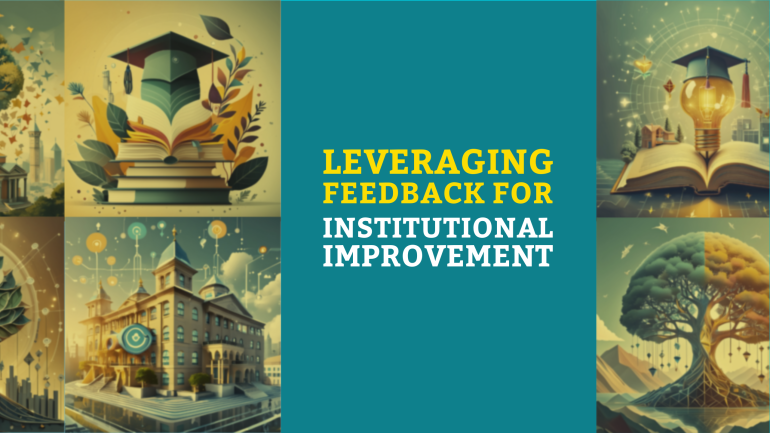Table of Contents
TL;DR: Leveraging Feedback for Institutional Improvement
- Feedback is imperative: Feedback plays a crucial role in identifying areas for improvement within an institution.
- Utilize various feedback sources: To gain a comprehensive understanding of areas for improvement, an institution should collect feedback from diverse sources such as students, faculty, staff, and stakeholders.
- Develop a structured feedback system: Establishing a formal process for collecting, analyzing, and implementing feedback is key to leveraging it for institutional improvement.
- Continuous improvement mindset: Encouraging a culture of continuous improvement based on feedback helps institutions adapt to changing needs and stay relevant.
- Transparency and communication: Communicating the results of feedback analysis and actions taken based on feedback builds trust and demonstrates a commitment to improving the institution.
There’s no denying the power of feedback in enhancing the performance and effectiveness of any institution. Whether it’s a school, a company, or a non-profit organization, feedback serves as a valuable tool for identifying strengths, weaknesses, and areas for growth. In this blog post, we will research into the significance of feedback in driving institutional improvement and explore strategies for effectively leveraging it to bring about positive change and progress.
Understanding Feedback Sources
Internal Feedback Channels
On the internal front, feedback can come from various sources such as employees, managers, and different departments within the institution. This feedback is crucial as it provides insights into the daily operations, work environment, and organizational culture. Developing efficient internal feedback channels can foster a culture of transparency and continuous improvement.
External Feedback Channels
Internal feedback is vital, but external feedback channels are equally important. They include customer surveys, reviews, and industry benchmarking. This input from external stakeholders offers a critical perspective on the institution’s performance, service quality, and market positioning. It is vital to actively seek and monitor this external feedback to stay competitive and responsive to the demands of the market.
Understanding external feedback channels involves recognizing the significance of feedback from customers, suppliers, and other external partners. This feedback provides valuable insights into market trends, customer preferences, and areas for improvement. By incorporating external feedback into decision-making processes, institutions can strengthen their competitive edge and drive continuous growth.
Feedback Analysis and Implementation
Organizing and Interpreting Feedback
If you want to leverage feedback for institutional improvement, organizing and interpreting it is key. This involves categorizing feedback based on themes, such as teaching quality, facilities, or support services. By identifying patterns and trends in feedback, institutions can prioritize areas for improvement and allocate resources effectively.
Integrating Feedback into Strategic Planning
Organizing feedback into strategic planning involves aligning the feedback with the institution’s goals and objectives. By incorporating feedback into strategic planning processes, institutions can ensure that improvement efforts are focused on areas that will have the most impact. This integration also fosters a culture of continuous improvement and accountability.
For instance, by integrating feedback into the institution’s strategic planning, leaders can set specific goals for improvement based on the feedback received. They can then develop action plans with measurable targets and timelines to track progress. This approach ensures that feedback is not just collected for the sake of it but is used to drive meaningful change within the institution.
Building a Feedback-Rich Culture
Training and Development for Feedback Literacy
Development of a feedback-rich culture begins with providing training and development opportunities for all members of the institution to enhance their feedback literacy. By educating individuals on the importance of feedback, how to give constructive feedback, and how to receive feedback openly, a culture of continuous improvement can be fostered. Your institution should invest in workshops, seminars, and resources to empower staff at all levels to effectively engage in feedback processes.
Encouraging Continuous Improvement through Open Communication
Communication is key in creating a feedback-rich culture. Encouraging open communication channels where feedback can flow freely is necessary for institutional improvement. Establishing platforms for staff and students to share their thoughts, ideas, and concerns can help in identifying areas for growth and development. By fostering a safe and transparent environment, individuals will feel empowered to voice their feedback, leading to a more collaborative and innovative institution.
Measuring the Impact of Feedback Actions
Indicators of Institutional Improvement
To measure the impact of feedback actions on institutional improvement, it is imperative to establish clear indicators. These indicators could include changes in overall student satisfaction rates, improvements in academic performance, increased retention rates, enhanced employee morale, and better community engagement. By tracking these indicators over time, institutions can effectively gauge the effectiveness of their feedback initiatives.
Long-term Benefits of a Feedback-Oriented Approach
Impact on institutional improvement is not just immediate but also has long-term benefits. A feedback-oriented approach fosters a culture of continuous improvement within an institution. This leads to better decision-making processes, increased accountability, and overall institutional growth. Institutions that prioritize feedback are more likely to adapt to changing needs and remain relevant in a dynamic environment.
For instance, institutions that regularly gather feedback from students and stakeholders can tailor their programs to meet evolving demands, resulting in higher enrollment rates and improved reputation. Additionally, a feedback-oriented approach can help institutions identify and address potential issues before they escalate, preventing costly consequences in the long run.
Final Words
On the whole, leveraging feedback for institutional improvement is a critical aspect of ensuring continuous growth and development within an organization. By actively collecting, analyzing, and implementing feedback from stakeholders, institutions can identify areas for enhancement, address concerns, and ultimately improve the overall functioning of the organization. It is imperative for institutions to create a culture that values and prioritizes feedback as a powerful tool for driving positive change and achieving excellence. By embracing feedback as a means for learning and growth, institutions can adapt to evolving needs, enhance transparency and accountability, and ultimately foster a culture of continuous improvement.
FAQ
Q: What is the importance of leveraging feedback for institutional improvement?
A: Leveraging feedback for institutional improvement is vital as it provides valuable insights into areas that need enhancement, helps in making informed decisions, and fosters a culture of continuous growth and development within the organization.
Q: How can institutions collect feedback effectively?
A: Institutions can collect feedback effectively through various channels such as surveys, focus groups, suggestion boxes, and one-on-one meetings with stakeholders. Utilizing multiple feedback sources allows for a comprehensive understanding of areas needing improvement.
Q: What are the key steps in leveraging feedback for institutional improvement?
A: The key steps in leveraging feedback for institutional improvement include analyzing feedback data, identifying patterns and trends, developing action plans based on feedback insights, implementing changes, and monitoring progress continuously to ensure effectiveness.
Q: How can institutions ensure that feedback leads to tangible improvements?
A: Institutions can ensure that feedback leads to tangible improvements by setting clear goals based on feedback insights, assigning responsibility for implementing changes, providing necessary resources for improvement initiatives, and regularly evaluating the impact of changes made.
Q: What are the benefits of effectively leveraging feedback for institutional improvement?
A: The benefits of effectively leveraging feedback for institutional improvement include enhanced stakeholder satisfaction, increased operational efficiency, higher quality of services or products, improved decision-making processes, and a competitive edge in the market.




